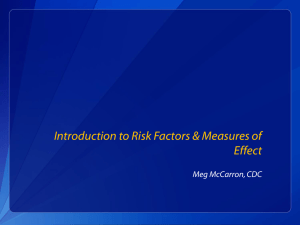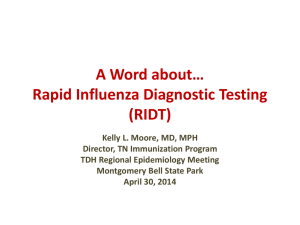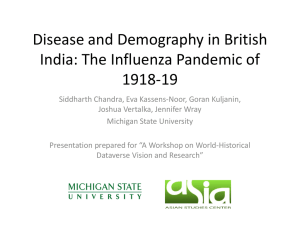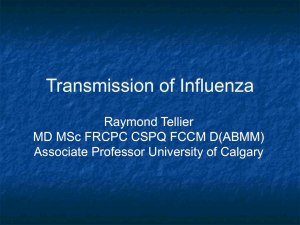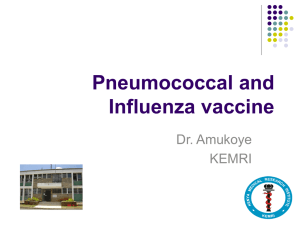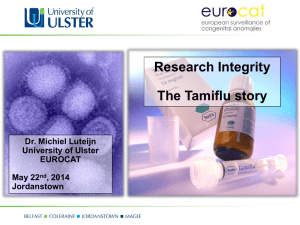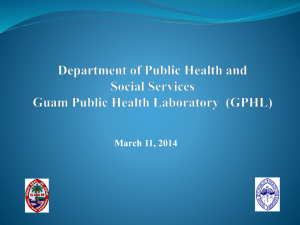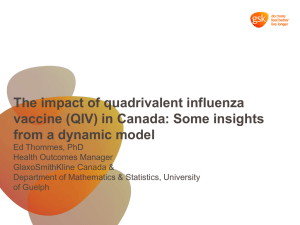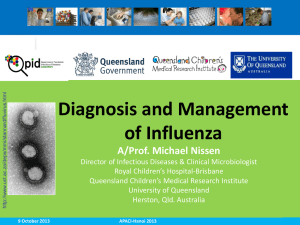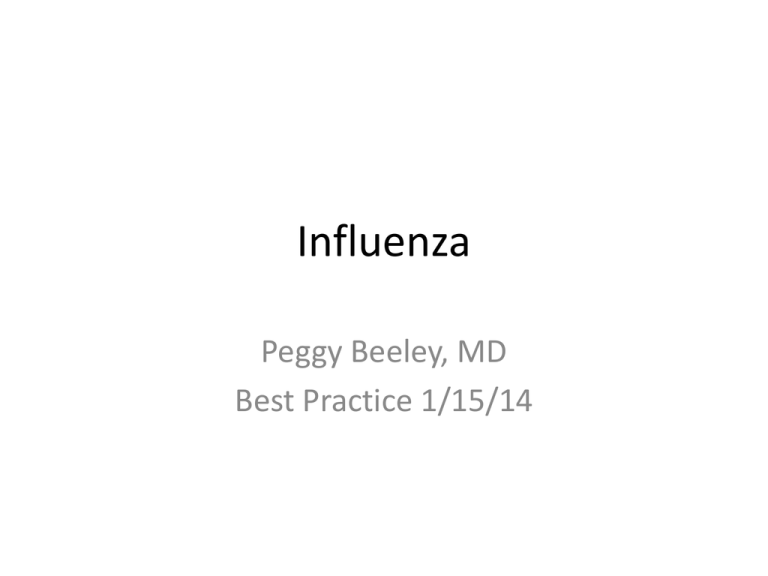
Influenza
Peggy Beeley, MD
Best Practice 1/15/14
Outline
•
•
•
•
•
•
Current Outbreak
Brief review of Influenza structure & subtypes
Transmission and Prevention
Available Testing
Treatment
Prophylaxis
Signs & Symptoms
•
•
•
•
•
•
•
Fever
Cough
Sore throat
Coryza or nasal congesting
Headache
Myalgias and fatigue
Nausea and vomiting may
occur
• Illness occurs during
influenza season
• Abrupt onset
Complications
• Primary viral pneumonia
• Secondary Bacterial
Pneumonia
• Croup
• Exacerbation of Chronic
Pulm Dz
• Otitis Media
• Sinusitis
• Myositis
• Cardiac Complications
• Toxic Shock Syndrome
• Reyes Syndrome
Most Recent Surveillance from CDC
Week 2 – 43 positive tests
Week 3 – 7 positive tests (through 1/12/14)
UNMH Admissions for
36.1% (22/61) of patients with positives tests were admitted to UNMH
2013-2014 Influenza Season
Of Note: Only patients who are to be hospitalized should be tested for respiratory viruses. Thus, this
likely does not represent the true burden of illness in the community or the severity of disease.
Characteristics of UNMH Admissions for 2013-2014 Influenza Season
Flu-related admissions
Pediatric Patients
Month
(n)
(< 19 yrs)
September
1
1
October
1 (transfer)
1
November
1
1
December
18
3 (17%)
January
22 (to date)
5 (23%)
TOTAL
43 patients
11 patients
Adult Patients
(≥ 19 yrs)
0
0
0
15 (83%)
17 (77%)
32 patients
Summary of inpatients from December 2013 – present
Average age: 36.7 years
Age range: 0 – 64 years
Sex: 53% (23/43) Females, 47% (20/43) Males
Location from which patients are admitted
30 (71%) patients were ED admits
12 (29%) were from clinics
Courtesy Dr. Meghan Brett
Characteristics of Admitted Patients
with Influenza
Average age: 36.7 years
Range: 0 – 64 years
Sex:
53% Female
47% Males
Admitted from:
71% from ED
29% from Clinics
All positive for Influenza A
Courtesy Dr. Meghan Brett
Influenza
• RNA viruses Orthomyxoviradae
• Influenza A
– Most morbidity & mortality
– Pandemic
• Influenza B
– > 60% Yamagata
– > 30% Victoria
• Influenza C
Structure of Virus
• Glycoprotein's.
– Hemagglutinin(HA)
• attaches to sialic acid
residues on host cells
– Neuraminidase (NA)
• glycoproteins attach to
host cells and releases
viral progeny
• Once infected, direct
necrotic effects on human
cells as virus begins to use
host cell machinery for
replication
Mandell, 2010
National Data for Influenza
2013-2014
Tricore Report
Respiratory Virus
Detection by
•
DFA, RESPAN and the FLURSV
Assay Methods
• 889 requests with 418
positive(s)
• Influenza A H1 (2009) 109
• Influenza A H3
1
• Influenza A
108
• Influenza B
1
Transmission & Prevention:
• Transmission
– Person to Person: Large particle
respiratory droplet (cough or
sneeze) within 6 ft or less
– Indirect contact via hand transfer
of virus-contaminated surfaces
or objects to mucosal surfaces of
the face
– All respiratory secretions, bodily
fluids, including diarrheal stools
are potentially infectious
– Airborne transmission via small
particle aerosols may occur
• Procedures
• Prevention
–
–
–
–
Vaccinations
Good hand hygiene
Cough etiquette
Wear mask if sick and on clinical
service
– Wear mask if unable to get
vaccinated
UNM’s Vaccine
• Efficacy for Influ A 70-90%
• Fluzone
– Split-virus vaccine
– Contains H3N2, H1N1, B
– Trivalent vs. Quadravalent
– Standard dosing vs High dose for Patients > 65 yo
• Flublok
– Egg free, grown in cell culture
• Early vaccination of inpatients
Influenza Vaccination by Group at UNMH,
Influenza Season 2013-2014
UNMH
UNM Residents
CRTC
UNM MG
UNMH Cred Providers
UNM Cred Providers
% Compliant
99.4%
65.6%
76.8%
58.4%
100.0%
74.4%
Date of Report: 1.10.14
Total Number of
Employees
6,099
633
323
351
245
1,102
Courtesy Dr. Meghan Brett
Influenza Vaccination Rates by Dept, 1.10.2014
Courtesy Dr. Meghan Brett
Department
Radiology
Emergency Medicine
Anesthesiology & Critical Care Medicine
Family & Community Medicine
Internal Medicine
Obstetrics & Gynecology
Pediatrics
Psychiatry
Orthopedics & Rehabilitation
Neurology
Dental Medicine
Surgery
Pathology
Dermatology
Neurosurgery
Percent Compliant
97.4%
95.2%
88.9%
87.7%
74.8%
73.7%
72.1%
66.7%
64.9%
64.3%
62.5%
52.6%
50.9%
50.0%
47.4%
Laboratory Testing
• Tricore runs all tests
• No clinic Ag testing
• 3 types of tests available
– DFA
– RESPAN
– FLURSV
• Coinfections: ~10%
– Usually rhinovirus and flu or RSV
– 1 Influenza A & B
Anti-flu therapy and prophylaxis
• Neuraminidase
Inhibitors:
– oseltamivir (Tamiflu)
– zanamivir (Relenza)
• Japan has two others
– laninamivir
– peramivir, IV form
• Adamantanes:
– Amantadine
– Rimantadine
• Ribavirin
Targets of Antivirals
Itzstein, M :Nature Review of Drug discovery,
vol 6 2007
Zanamivir
•
•
•
•
•
Trade name: Relenza
Higher affinity to the NA binding site than does native sialic acid.
Poorly absorbed in GI tract and thus delivered as an inhaled agent
Only 15% of drug deposits within lower respiratory tract
Can precipitate bronchospasm
– in pts with pulm dz
– cant be used in mechanical ventilation
•
•
•
•
Clinical trials for optimal dosing for IV form, compassionate use.
RX:10 mg inhaled twice daily for 5 days (approved for > 7 yr old)
Prophylaxis is given once daily for 10 days (up to28 days) age> 5
Higher activity for influenza B & H1N1 strains than oseltamivir, less activity
against H3N2
• Doesn’t have the H275Y neuraminidase mutation
• N294S (N295S) neuraminidase mutation seen in immunocompromised
causes decreased sensitivity to zanamivir
Oseltamivir
•
•
•
•
Trade name: Tamiflu
Prodrug converted in liver to active form
Dosing based on weight and renal function
Most common side effect is GI upset, improved
with food
• Neurologic side effects reported in children
mostly in Japan
• No IV admin
• Resistance can occur
CDC
Combination Therapy
• zanamivir and oseltamivir has been studied but
showed no benefit and greater viral loads
(competition for site)
• Triple combination of oseltamivir, amantadine
and ribavirin are being studied
– In vitro study (Hoopes, et al) looked promising
– Nguyen et al: looked at TCAD in murine model
• 90% survival with TCAD vs 20% with single agent oseltamivir
– Korean study (Kim et al)
• showed 24 pts, at 14 days 17% mortality for TCAD compared
with 35% oseltamivir alone
• low powered, no difference in 90 d mortality
Moscona A. N Engl J Med 2009; 360 (10): 953-6
Who Gets Treated
•
Antiviral treatment is recommended as early as possible for any patient with
confirmed or suspected influenza who
– is hospitalized;
– has severe, complicated, or progressive illness; or
– is at higher risk for influenza complications. This list includes:
•
•
•
•
•
•
•
•
•
children aged younger than 2 years;
adults aged 65 years and older;
persons with chronic pulmonary (including asthma), cardiovascular (except hypertension alone), renal,
hepatic, hematological (including sickle cell disease), metabolic disorders (including diabetes mellitus),
or neurologic and neurodevelopment conditions (including disorders of the brain, spinal cord,
peripheral nerve, and muscle such as cerebral palsy, epilepsy [seizure disorders], stroke, intellectual
disability [mental retardation], moderate to severe developmental delay, muscular dystrophy, or spinal
cord injury);
persons with immunosuppression, including that caused by medications or by HIV infection;
women who are pregnant or postpartum (within 2 weeks after delivery);
persons aged younger than 19 years who are receiving long-term aspirin therapy;
American Indians/Alaska Natives;
persons who are morbidly obese (i.e., body-mass index is equal to or greater than 40); and
residents of nursing homes and other chronic-care facilities.
– Consider in healthy individuals based on severity at presentation and how soon they present.
Prophylaxis
• Neuraminidase Inhibitors
– Close household contacts of persons with
influenza who have not received the vaccine and
who have comorbidities that could lead to
complications
– HCW who had not practiced proper precautions
– Person living in NH or LT care facilities
• Adamantanes class (amantidine and
rimantidine) are rarely used due to resistance
Summary Points
• Vaccinating health care workers is vital
• Vaccinate patients on admission when possible
• FLURSV has quickest turn around time, may be
preferred
• If influenza is suspected, start oseltamivir or
zanamivir (if available) before test results are
available.
• Avoid Adamantanes as all circulating flu is
resistant this year
References:
Boltz A, Drugs 2010; 70 (11): 1349-1362
CDC Health Alert Network, December 24, 2013
CDC Web site
Ginsberg J et al, Detecting Influenza epidemics using search engine query data
Nature 2009; 457
Groom A, Pandemic Influenza Preparedness and Vulnerable Populations in Tribal
Communities
American Journal of Public Health 2009; 99, No S2 271-277
Harper S, et al IDSA Clinic Practice Guidelines: Seasonal Influenza in Adults and
Children
CID 2009;48 1003-1032
H1N1 hitting young and middle-aged adults ACP Hospitalist Weekly, Jan 8 2014
Kamali A, Holodniy M, Infection and drug Resistance Nov18 2013:6 187-198
Polgreen P, et al Using Internet Searches for Influenza Surveillance, CID 2008; 47
Prevention and control of Seasonal Influenza with Vaccines, ACIP, MMWR 9/20/2013;62
No7
Nature Reviews Drug Discovery 6, 967-974 (December 2007)
Useful web sites
http://www.cdc.gov/flu/
http://google.org/flutrends
www.tricore.org


